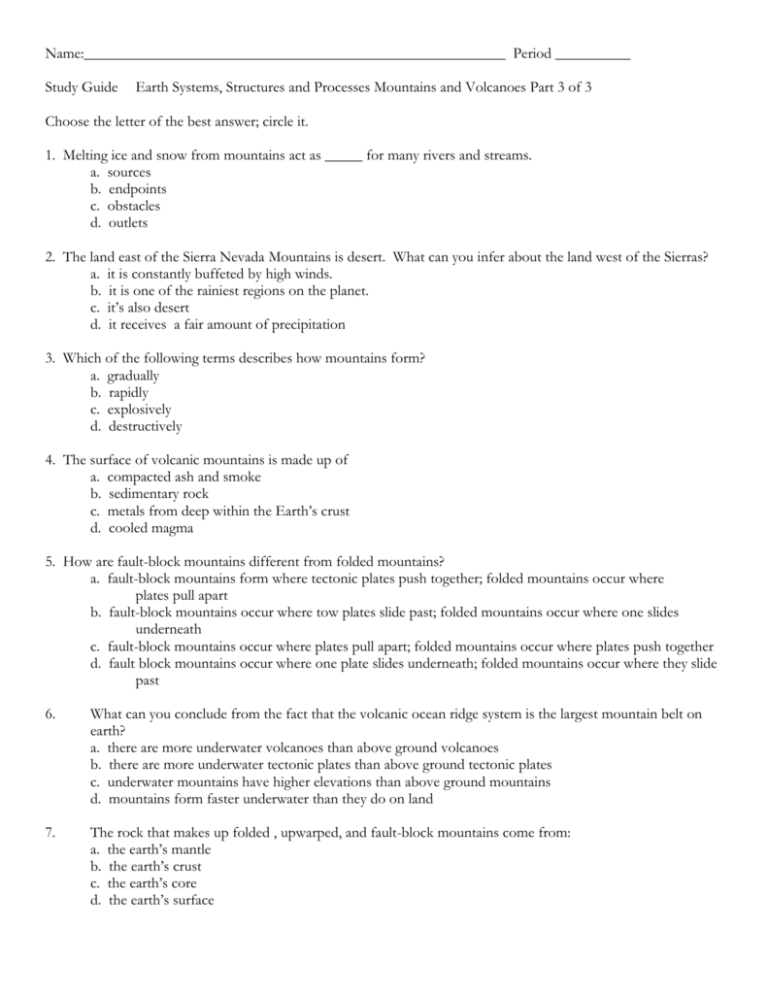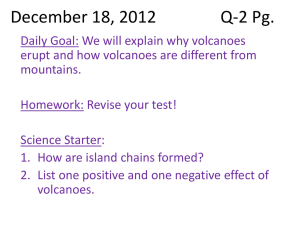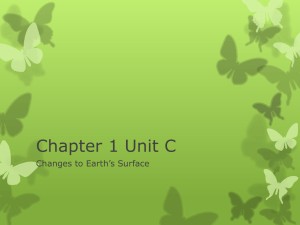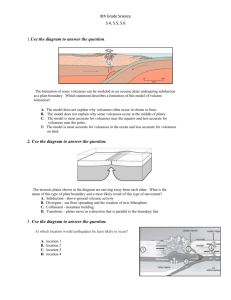Name: Period ______ Study Guide Earth Systems, Structures and
advertisement

Name:________________________________________________________ Period __________ Study Guide Earth Systems, Structures and Processes Mountains and Volcanoes Part 3 of 3 Choose the letter of the best answer; circle it. 1. Melting ice and snow from mountains act as _____ for many rivers and streams. a. sources b. endpoints c. obstacles d. outlets 2. The land east of the Sierra Nevada Mountains is desert. What can you infer about the land west of the Sierras? a. it is constantly buffeted by high winds. b. it is one of the rainiest regions on the planet. c. it’s also desert d. it receives a fair amount of precipitation 3. Which of the following terms describes how mountains form? a. gradually b. rapidly c. explosively d. destructively 4. The surface of volcanic mountains is made up of a. compacted ash and smoke b. sedimentary rock c. metals from deep within the Earth’s crust d. cooled magma 5. How are fault-block mountains different from folded mountains? a. fault-block mountains form where tectonic plates push together; folded mountains occur where plates pull apart b. fault-block mountains occur where tow plates slide past; folded mountains occur where one slides underneath c. fault-block mountains occur where plates pull apart; folded mountains occur where plates push together d. fault block mountains occur where one plate slides underneath; folded mountains occur where they slide past 6. What can you conclude from the fact that the volcanic ocean ridge system is the largest mountain belt on earth? a. there are more underwater volcanoes than above ground volcanoes b. there are more underwater tectonic plates than above ground tectonic plates c. underwater mountains have higher elevations than above ground mountains d. mountains form faster underwater than they do on land 7. The rock that makes up folded , upwarped, and fault-block mountains come from: a. the earth’s mantle b. the earth’s crust c. the earth’s core d. the earth’s surface 8. At which types of boundaries do subduction zones occur? a. the boundaries between nations b. the boundaries between oceans c. the boundaries between plains and forested lands d. the boundaries between tectonic plates 9. What might happen if a major volcanic eruption occurred every year? a. global temperatures might rise by several degrees b. the earth’s crust might be depleted of rocks c. global temperatures might cool by several degrees d. northing out of the ordinary 10. Why are the eruptions of statovolcanoes usually more destructive than the eruptions of cinder cone volcanoes? a. because more pressure builds up inside stratovolcanoes, causing powerful eruptions b. because lava flows out of several openings in stratovolcanoes c. because statovolcanoes erupt more frequently d. because the magma in stratovolcanoes is hotter 11. Which of the following volcanoes is the least destructive? a. stratovolcano b. a dormant volcano c. a shield volcano d. a cinder cone volcano 12. What can you infer about the Hawaiian Islands from the fact that they formed from shield volcanoes? a. They formed in a matter of minutes b. they are composed mainly of basalt c. the ground there is extremely hot d. older islands were destroyed when Hawaii was formed 13. Which of the following countries lies along the Ring of Fire? a. South Africa b. Norway c. Japan d. Iran 14. Which of the following best describes magma? a. molten rock that flows over Earth’s surface b. solid rock at Earth’s surface c. molten rock beneath Earth’s surface d. solid rock beneath Earth’s surface 15. Magma can form when a. molten rock cools on the ocean floor b. a sinking tectonic plate begins to melt c. magnetic changes occur below Earth’s surface d. rock is exposed to wind, water, and air at Earth’s surface 16. In the middle of tectonic plates, volcanoes may form over a. hot spots b. cooling centers c. continental-continental collision zones d. oceanic-continental collision zones 17. What happens along a subduction zone? a. two continental plates come together b. two oceanic plates pull apart c. a continental plate sinks into the mantle d. an oceanic plate sinks into the mantle 18. What is a spreading center? a. a place where continental plates come together b. a place where oceanic plates pull apart c. a place where plates move horizontally past each other d. a place where plates move vertically past each other 19. During the formation of fault-block mounts, the lithosphere a. folds b. stretches c. shrinks d. collides 20. Why are tilted blocks of rock common along mid-ocean ridges? a. plates come together at these tectonic boundaries b. plates move apart at these tectonic boundaries c. plates move past one another at these tectonic boundaries d. plates sink and melt along these tectonic boundaries 21. What is one way that a folded mountain belt can form? a. two oceanic plates spread apart b. two continental plates push together c. old volcanoes erupt and grow d. blocks of crust move along faults 23. Volcanoes in folded mountains belts form when a. a continental plate moves over a hot spot b. an oceanic plate is broken by faults c. an oceanic plate partly melts as it goes in to the mantle d. a continental plate crumples as it collides with another plate 24. An opening through which lava, rocks, and gases erupt is called a a. caldera b. fumarole c. volcano d. geyser 25. A dense cloud of super hot gases and rock fragments that races downhill from an erupting volcano is called a. pyroclastic flow b. steam explosion c. cinder eruption d. landslide 26. Most volcanoes occur a. in the center of a continent b. along plate boundaries c. along fault zones d. over hot spots 27. Scientists monitor volcanoes to a. prevent future eruptions form occurring b. predict when future eruptions will occur c. prevent gases from escaping through openings in Earth’s crust d. cool the temperature of the magma rising inside the volcano 28. Hot springs that erupt and send hot water shooting into the air are called a. fumaroles b. oceanic ridges c. geysers d. deep-sea vents 29. What is a volcano? a. a chamber of magma deep beneath the surface b. a mountain that forms as the result of faulting c. an opening through which lava, rocks, and gases erupt d. a huge crater that forms as the result of collapsing rocks 30. What makes a pyroclastic flow so dangerous? a. its speed and its temperature b. its temperature and its silica content c. it speed and its cinder content d. its temperature and its volume 31. Volcanoes form at a. converging boundaries and diverging boundaries only b. hot spots and faults only c. diverging boundaries and hot spots only d. converging boundaries, diverging boundaries and hot spots 32. Which of the following signs might indicate that a volcano might soon erupt? a. increased wearing away of volcanic rocks b. rising temperatures in volcanic lakes c. falling temperatures in volcanic lakes d. decreased wearing away of volcanic rocks 33. Which of these can be dangerous to people whom live hundreds of kilometers from an erupting volcano? a. volcanic ash clouds b. lava flows c. landslides d. volcanic soil 34. Which of the following lists the rock fragments released by a volcano in order from smallest to largest? a. bombs, blocks, cinders b. cinders, bombs, ash c. blocks, ash, cinders d. ash, cinders, bombs 35. How do volcanoes contribute to acid rain? a. They spray out liquid sulfuric acid during pyroclastic flows b. their intense heat releases acid from the lava c. they release carbon dioxide gas, which is naturally acidic and poisonous d. they release sulfur dioxide and other gases that mix with water and form acids 36. Earthquakes and volcanic activity occur along the Ring of Fire. Which of the following best explains why? a. it is located at the boundaries of tectonic plates b. it is located at the boundary of deep and shallow water c. it is located where the major ocean current meets d. it is located where ocean temperature is the highest 37. Which causes the movement of tectonic plates? a. gravitational pull between Earth and the moon b. convection occurring beneath the Earth’s crust c. energy produced by earthquakes within the Earth d. rotation of liquid rock found within the Core 38. Which most likely occurs when two continental plates are pushed into one another? a. the plates will stop moving b. the plates will form a trench c. the plates will form a mountain d. the plates will break into pieces 39. 1n areas where the lithosphere is being pulled apart, the crust a. folds and crumples into mountains b. breaks into blocks separated by faults c. slides down into the mantle d. develops a subduction zone 40. Before magma erupts it collects under a volcano in a a. chamber b. caldera c. crater d. vent 41. The explosiveness of a volcanic eruption depends mostly on the _______ of the magma. a. gas content b. silica content c. amount d. temperature 42. The type of magma erupting from a volcano determines the volcanoes a. size b. age c. shape d. location 43. Volcanic ash can be carried thousands of kilometers from an eruption by a. lava flows b. pyroclastic flows c. landslides d. winds 44. In a volcanic region, water moving through the ground gets _____ by magma or hot rock. a. melted b. dissolved c. erupted d. heated True or False. Write true or false on the line beside the statement. If it is false, write the word(s) that it needs to be changed to make it true. (51 is a bonus question/extra points) 45. Silica-rich magma erupts from shield volcanoes, giving them their broad, flat shape. ______________________________ 46. Volcanic mudflows are especially likely in dry regions. ______________________________ 47. Steam explosion, which occur when magma contacts water, can be devastating. ______________________________ 48. Most acid precipitation forms as the result of volcanic eruptions. ______________________________ 49. Hot springs and geysers are the result of surface water being heated by hot rock or magma. ______________________________ 50. Underground water heated by magma can be use to provide energy at Earth’s surface. ______________________________ 51. Deep-sea vents are hot springs that form on Earth’s ocean floors. ______________________________







